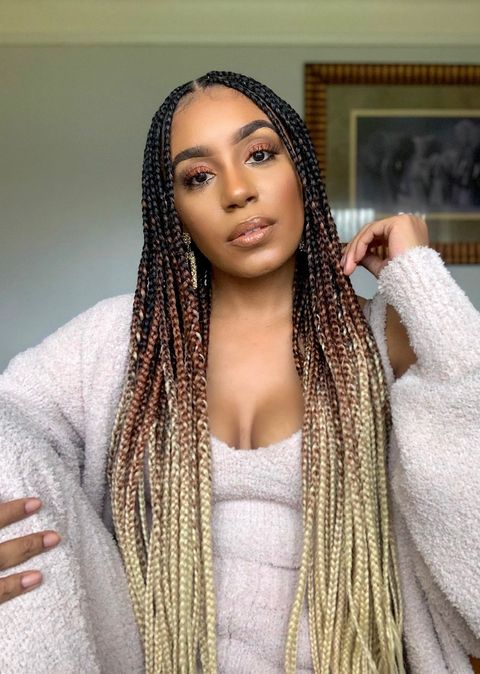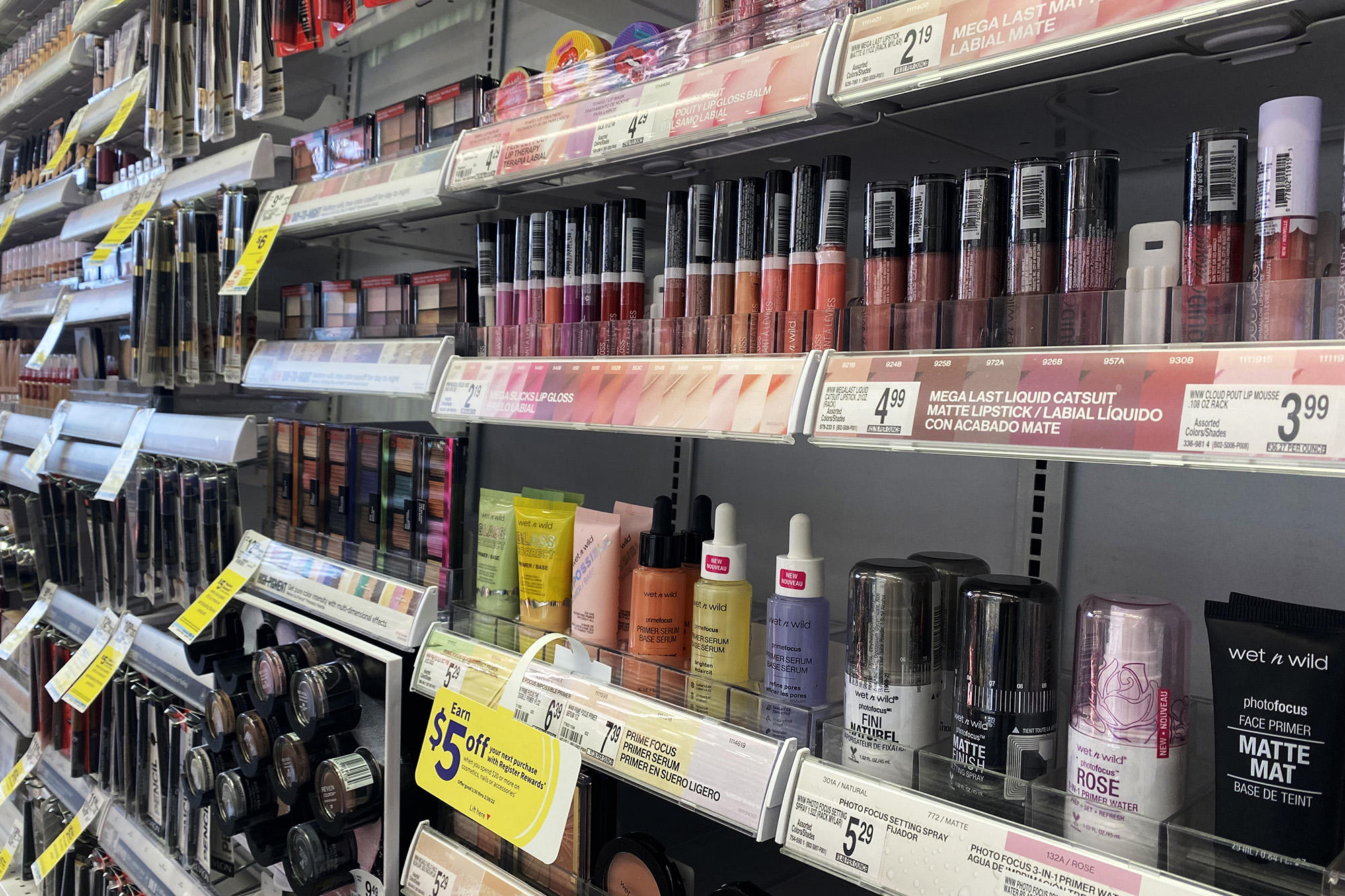From freezing rain that drenches your scalp to swirling winds that suck moisture right out of your hair, the coldest season of the year demands greater attention to your hair-care regime. No matter how much snow is on the ground, keeping your tresses looking and feeling healthy should be a key component of your daily routine in the winter.
Steaming locks, rocking satin-lined winter hats, and keeping up with those trims are among the many methods of ensuring your hair stays protected. Shondaland asked hair experts for their advice on which products, treatments, and routines to incorporate into your hair regime as we ride out the rest of the winter.
Wait for wet hair to dry
It’s tempting to rush out of the house after washing your hair, but you should wait until your hair is completely dry. “The water in your hair strands could end up freezing, causing the hair’s cuticle to expand and become exposed and vulnerable to drying out and getting damaged,” explains Melanin Haircare founder Whitney White, adding that cold air on wet hair also contributes to moisture loss and an itchy scalp.
This content is imported from Instagram. You may be able to find the same content in another format, or you may be able to find more information, at their web site.
Lock in the moisture
In the winter, hair oil is a particularly useful product for your mane; it helps hair stay soft, grow strong, and retain moisture. In lower temperatures, hair often becomes dry and brittle, leading to split ends. Be careful not to use too much because it can weigh your hair down and clog up your scalp’s pores, causing itching and flaking.
For a strong winter oil, try Romance Cox’s Revitalizer Oil Blend. The fan-favorite oil from Cox, a beauty and natural-hair content creator from Cleveland, Ohio, is made with cedarwood and saw palmetto, both known to strengthen hair. “[The oil] has about 10 ingredients,” she says, “that focus on moisturizing hair so that it grows.”
Clarify your scalp
During the winter, both daily and deep conditioning are a must. But all that product can lead to buildup, which damages your scalp and weighs down strands. “It’s super-important to thoroughly cleanse your scalp and hair during the winter [because] many of the thicker products can easily sit on the hair, causing buildup if not removed properly,” says Nia Pettitt, a Zimbabwean British stylist and the founder of the salon the Curl Bar London.
This content is imported from Instagram. You may be able to find the same content in another format, or you may be able to find more information, at their web site.
Use a clarifying shampoo about once a month (or more frequently if you have hard water). For scalp care, Pettitt recommends the Scalp Revival line from Briogeo, a Black woman-owned company with products that work for all hair types. Briogeo’s moisturizing Charcoal + Coconut Oil Micro-Exfoliating Shampoo removes buildup and prevents flaking. Another option is TPH by Taraji’s Master Cleanse scalp rinse. The tri-touch applicator makes it easy for direct scalp cleansing, which is especially useful for those with braids or weaves.
While clarifying shampoos are necessary, don’t overuse them. They can be very drying, especially for coily or high-porosity hair. “For hair textures that are thicker,” Cox says, “you’re definitely going to want to use more moisturizing shampoos than clarifying ones.” She recommends Design Essentials’ Almond & Avocado Moisturizing & Detangling Sulfate-Free Shampoo.
Pay attention to what you wear
Winter means feeling cozy in sweaters, but certain fabrics can actually damage your coif. White warns to be cautious about how your clothes — especially scratchy fabrics and knits with lots of grooves — might be damaging your hair. “People tend to wear more sweaters containing wool and other knitted fabrics that often rub against the hair, causing the cuticle layers to become open, worn, and damaged,” she says. If you notice your hair snagging on a particular item, she suggests wearing a ponytail or bun with it instead.
Steam your hair
One of the best ways for your hair to absorb deep-conditioning treatments is to ask your stylist to steam your hair or try doing it yourself with a few key tools. Cox notes that steaming is also good for refreshing curls. “A lot of us don’t want to wash our hair a lot in the wintertime,” she says, “but you can run a steamer through your hair with some product, style it, and add more moisture.” Cox’s recommended steamers include the Gold ’N Hot Soft Bonnet Dryer and Q-Redew’s handheld steamer.
Try a protective style
Protective styles can vary, but their purpose is to defend your hair from the elements and stress of daily manipulation. Braids, weaves, and wigs are examples of protective styles, as are satin-lined headscarves. It’s important to continue to take care of your hair with regular washing and moisturizing between protective styles.
Safeguard your hair at night
Atlanta-based beauty blogger and entrepreneur Dayna Bolden relies on a bonnet during the wintertime. Sleeping with satin against your hair keeps the strands from snagging and breaking on rougher material like cotton. Pettitt agrees, noting that a “silk pillow never goes to bed without me and my curls.”
The experts agree that you should follow this routine — bonnet and pillowcase — every night, but it’s especially important in the winter. “A satin-lined hat can go a long way for your hair’s health,” Bolden says. Beautifully Warm is a Black woman-owned business that sells cute satin-lined winter hats for the whole family, including the kiddos. For a head wrap, White recommends the Melanin Haircare Stretch Satin Head Wrap. “It has been key in getting me to and from my kids’ school and work without drying out my hair,” she says, “and I always get compliments on how cute they look.”
Understand porosity
For hair care, many experts say it’s important to know your hair’s porosity level. Low-porosity hair doesn’t absorb products or water as easily, while high-porosity hair soaks up liquids like it’s happy hour. Both types are healthy and normal, but certain products and routines work better depending on your porosity.
Bolden has low-porosity hair. For her, deep-conditioning treatments in the winter are a must. “The cold air dries out my hair, so I have to make sure to keep it hydrated and nourished,” she says. “For high-porosity hair, I would recommend a deeply moisturizing leave-in conditioner. This hair type loses moisture faster, so daily upkeep is paramount.”
Regularly trim your hair
The key to achieving healthy hair, including length retention, is regular trims. “The hair on our ends is the oldest part of our hair, so it is more prone to breakage,” Pettitt says. “If you do not trim it, then that breakage can travel up the hair, causing your hair to weaken.” To avoid brittle and split ends traveling up your hair shaft, make sure to regularly trim your hair with your stylist. Pettitt trims her hair every three months, while Cox does it every six months. Consult with your stylist, and take note of how fast your own hair tends to get split ends.
Professional trims and cuts are always the safest option, but you can also give yourself trims at home. “Make it fun [and] do it with a friend or your partner,” Cox suggests. “Because you can’t see the back of your head, it’s always good to work with two people so that you catch all those areas.” If you need guidance, White has detailed tutorials on how to cut natural hair at home.
Quality shears are essential when trimming your own hair because dull scissors can catch on the hair and cause more damage. The Fromm Explore 5.75’’ Shears are inexpensive and highly rated. The JW Shears XO Professional Shear and Blending Kit is a more expensive option that includes thinning scissors, which are great for shaping up bangs and creating layers.
When cutting or trimming your hair, do it in your hair’s regular state. “If you’re normally wearing your hair in a wash and go, then you may want to cut your hair while it’s wet and curly,” Cox advises. “But if you wear it straight, cut it while it’s blown out.”
Manage the heat
Cox points out that winter is a good time to wear more styles that require heat. “We’ve been accustomed to thinking winter is bad for our hair, when it can actually be good for our hair,” she says. “In the summer, humidity is causing your hair follicles to swell, so heat styles require more touch-ups, which causes more damage.” But Cox says heat styles have a longer life in the wintertime because of lower humidity, especially if you sleep with flexi rods or wrap your hair, which can give heat-styled hair more longevity.
For heat styling, use a strong heat protectant that protects hair up to 450 degrees. Apply a wet one — like a cream or water-based spray — for blow-drying and a dry one for flat-ironing to ensure complete protection at every step. For blow-drying, Briogeo’s Blow Dry Perfection & Heat Protectant Crème is silky and softening. If you’re using a flat iron or curlers, dry options include Olaplex’s No. 7 Bonding Oil for damaged hair and Moroccanoil’s Perfect Defense Heat Protectant for fuller coverage.
Track what works best for you
Pettitt doesn’t pay much attention to porosity. Instead, the stylist and salon founder says she “just looks at my hair and follows what it specifically needs.” She recommends creating a hair diary like this one from Etsy, which includes lots of room to track important details about hair density and DIY hair-product recipes. “If you notice that your hair responds well to something, then jot it down,” Pettitt says. “Notes on what your hair liked and didn’t [can] help you understand your own hair.”
Nylah Burton is a Chicago-based writer. Follow her on Twitter @yumcoconutmilk.
Get Shondaland directly in your inbox: SUBSCRIBE TODAY
This content is created and maintained by a third party, and imported onto this page to help users provide their email addresses. You may be able to find more information about this and similar content at piano.io







